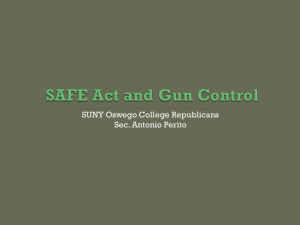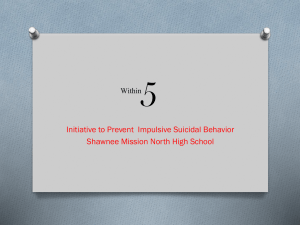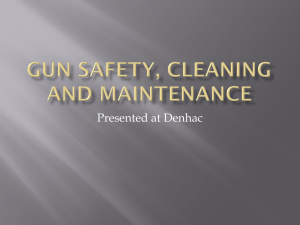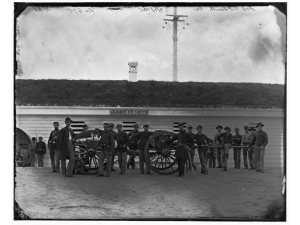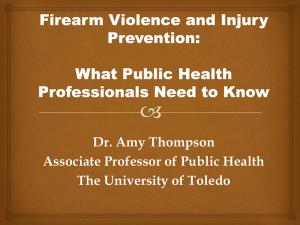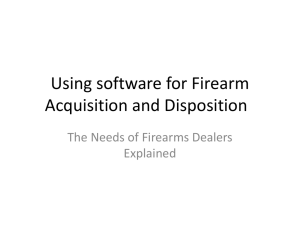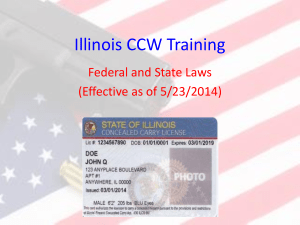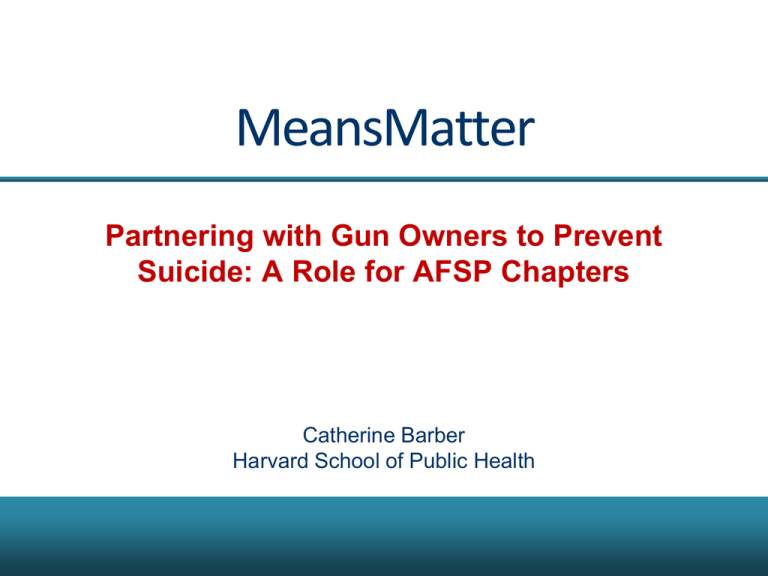
MeansMatter
Partnering with Gun Owners to Prevent
Suicide: A Role for AFSP Chapters
Catherine Barber
Harvard School of Public Health
Sri Lanka & Pesticides
• Pesticides are the leading suicide method in Sri Lanka.
• The most highly human-toxic pesticides were no longer
imported in the mid to late 1990s.
• Suicide rates dropped 50% from 1996 to 2005.
• Nonfatal pesticide attempts, and suicide by other methods,
did not drop.
Gunnell 2007. Int’l J of Epidemiology.
Firearms – Israeli Military
• The Israeli Defense Force (IDF) is a population-based
army with mandatory draft for 18-21 year-olds in Israel.
• Most suicides by firearm, many on weekends during leave.
• In 2006, IDF required soldiers to leave their weapons on
base during weekend leaves.
• The suicide rate decreased by 40%.
• Weekend suicides dropped significantly.
• Weekday suicides did not.
Lubin 2010, Suic & Life-Threat Behavior.
Why Does It Work?
The acute phase of a suicidal crisis
is often (not always) brief.
Another 47% said under an hour.
Only 13% said one day or more.
Self-Harm Case Fatality Rates
1-2% fatal
85-90% fatal
98% nonfatal,
ED-treated
10-15%
nonfatal,
treated in
hospital ER
Firearms
Cutting
& Poisoning& Sharps
Poison (overdose)
Source: CDC WISQARS <http://www.cdc.gov/ncipc/wisqars/>
Self-Harm Case Fatality Rates
85-90% fatal
1-2% fatal
98% nonfatal,
treated in
hospital ER
10-15%
nonfatal,
treated in
hospital ER
Firearms
Poison (overdose) & Sharps
Source: CDC WISQARS http://www.cdc.gov/ncipc/wisqars/
NOTE: This information should not be broadly disseminated to general public. People’s perception
that overdose and cutting are more lethal than they usually are probably saves many lives.
But Is It Truly a Life Saved?
• What proportion of serious attempters
eventually die by suicide?
75%
45%
25%
10%
Review of 90 studies: 90% or more of attempters did not go on to die by
suicide, even serious attempters such as those jumping in front of a subway
and even when followed 10+ years. 20-25% made a nonfatal reattempt.
Owens, Br J Psych, 2002.
Why Means Matter
1. The acute phase of a suicidal crisis is often (not
always) brief.
2. Lethality varies greatly by method. Intent matters
but means also matter, and method choice is often
governed by what’s readily at hand.
3. Most people who attempt and survive do not go
on to die by suicide.
Methods of Self Harm
Overdose/
Suffocation Poison
17%
25%
Jump 2%
Sharp 2%
Other 4%
Overdose/Poison
83%
Sharp
11%
Firearm
51%
Suffocation 1%
Firearm 1%
Suicide
SOURCES Suicide: CDC WISQARS (2010) www.cdc.gov/ncipc/wisqars
Other 4%
Nonfatal Self-harm
Inpatient: HCUP-NIS (2005)
Why Focus on Firearms?
• Leading U.S. method. More than all other methods
combined.
• Highly lethal.
• Accessible. >1/3 of homes have guns.
• Acceptable. Some methods, like fire, are entirely
accessible but are not acceptable to most U.S. attempters.
• Fast, Irreversible. No chance for rescue or change of heart
once the trigger is pulled. For nearly all other methods
except jumps there is an opportunity.
• Risk factor. Every U.S. case control study that has
examined the issue (15+) has found firearm access a risk
factor.
Engaging Gun Owners
• Gun owners and their families are dying by suicide at
higher rates than non-gun owners.
• Like older white men, people with mental health
problems, people with family hx of suicide, etc., gun
owners are “our” people. How do we reach them?
• Do we reach them with an anti-gun agenda? No.
• That’s like sending an anti-gay group to do a suicide
prevention campaign in the gay and lesbian
community.
• If you don’t trust the messenger, you don’t trust the
message.
How Did We Save Robert?
Parent: “I’m really worried about my son; he’s taking the
break-up really hard and his drug problem is getting
worse. I’m worried he might kill himself.”
Confidante (Therapist, neighbor, hotline worker, etc.):
“Is there someone who can hold onto your guns for the
time being? Have you asked him if he’d like to talk with
a counselor?”
• Everyone’s heard the phrases “designated driver” and
“friends don’t let friends drive drunk” now.
• How do we get that same reach and apply the same
friends-protecting-friends approach to means restriction?
Disseminating the Message
• Providers
• Gatekeepers
• Community
Lethal Means Counseling
• Counseling on Access to Lethal Means – Free online training
by Harvard, Dartmouth, & SPRC
http://training.sprc.org
Building It Into the System
Change policies & information systems
State Hospital
Association
State Social
Work
Association
Hospital
Administration
Emergency
Dept. Social
Worker
Graduate
School
What Providers/Gatekeepers?
•
•
•
•
•
•
•
•
•
•
•
•
•
Court-remanded batterer’s counseling, anger management
Rehab counselors
Marriage counselors
Defense attorneys, probation, parole
Truant officer, coach, teacher, principal, nurse
Pediatricians, ED clinicians, nurses
Police
Social workers
Employee assistance projects
Divorce attorneys
Clergy
Nurses
Etc.
Disseminating the Message
• Providers
• Gatekeepers
• Community
Natural Alliances
• Who among your suicide prevention networks are gun
owners?
• Use natural networks—hunting clubs, firearm safety
classes, gun shops, gun rights clubs, firearm
publications/newsletters, etc., to promote suicide
awareness as a basic tenet of responsible firearm
ownership and firearm safety.
• If none of your coalition members are gun owners,
find natural opportunities to reach out to gun owners
for cross-training and cross-fertilization of ideas.
(New Hampshire Gun Shop project is a good
example.)
Firearm Safety Culture
• Gun owner organizations are very safety oriented.
• Tremendous emphasis on preventing gun accidents (which
account for 600-800 deaths a year).
• Expanding that focus to include preventing firearm
suicides (which account for 19,000 deaths a year) falls well
within the safety culture of gun groups.
The NH Gun Shop Project
Mission
Coalition of gun dealers, gun rights advocates,
mental health and public health professionals.
• Educate gun shop owners about steps to avoid selling a
firearm to a suicidal customer (to avoid the nearly 1-in10 firearm suicides with recently purchased guns)
• Educate customers about making their firearms
inaccessible if a family member is in crisis and
disseminate the suicide helpline number (to help prevent
the much larger number of suicides that involve an existing
household gun).
Evaluation
• Visited all stores unannounced to see if products on
display
• 48% were observed using at least one of the materials
In Ten Years…
• Providers/Gatekeepers – raising the issue of firearm access
to suicidal people is second nature.
• Gun-owning community – every firearm safety class,
website, brochure, etc., mentions suicide prevention
The 11th Commandment of Firearm Safety
Be alert to signs of suicide or crisis among your loved
ones; if they are at risk of hurting themselves or others,
keep firearms from them until the situation has resolved.
keeping
Examples of Firearm Interventions
• Gun shop projects (e.g., NH, TN, MD, Shasta County CA)
• Nevada: Gun show displays in Las Vegas
• Colorado: Training hospital EDs in lethal means
counseling
• Texas: Firearm instructors module
• Means Matter/CALM/QPR firearms dealer training
narrated by Paul Quinnett (available at
http://www.youtube.com/watch?v=MAKp0HSorBw)
• 5 minute Means Matter slide deck as an add-on to
gatekeeper trainings
• VA: gun lock give-aways with National Shooting Sports
Foundation; home visits to suicidal vets by peers
For more information
Means Matter website: www.meansmatter.org
Take CALM-Online—free, online course on Counseling on Access
to Lethal Means http://training.sprc.org/
Download gunshop materials: www.nhfsc.org
Request technical assistance from Means Matter
cbarber@hsph.harvard.edu
Request an in-person CALM training
elaine.m.frank@dartmouth.edu


